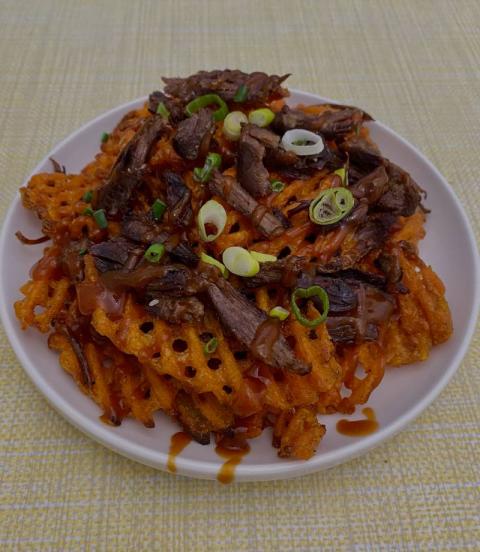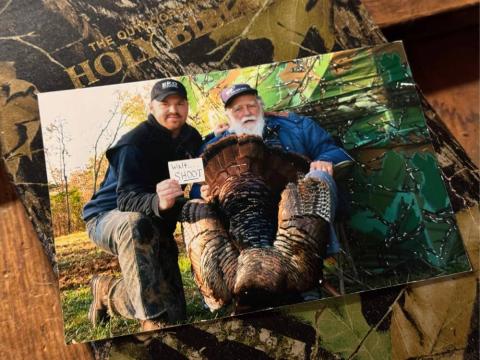Brad Mormann | Originally published in GameKeepers: Farming for Wildlife Magazine. To subscribe, click here.

The late winter dormant season is the most popular time to conduct prescribed burns, but is this timing right for your prairie, savanna or woodland? It all comes down to your goals and objectives—and your willingness to get a little sweaty. Depending on the exact timing, “growing season burns” have a couple of distinct advantages over “dormant season burns.” These advantages include vegetation suppression of some types, increased vegetation of others, and greater biodiversity. Suppressing a particular vegetation type, while encouraging others is a major part of land and wildlife management. This process has been going on for millennia as fires swept across our prairies, savannas and woodlands. The fun aspect today is that for the most part, we control when a burn occurs on our property allowing us to maintain or transition habitat types according to our goals.

they have grown 4 inches tall in the spring robs their
roots of energy. This provides an opportunity for a
diversity of wildlife friendly plants to sprout and gain a
foothold.
Cool Season Grasses: Weakening the Competition
One of the most common transitions that I like to implement is from a cool season grass dominated field to one containing a mix of native warm season grass, forbs, legumes and shrubs. Cool season grasses such as fescue and smooth brome have been a staple for farmers across the country wanting to stabilize soil and feed cattle. These cool season grasses are often selected because they are remarkably hardy and easy to establish and maintain compared to their warm season counterparts. However, because they are often planted in monocultures the quality of the habitat they provide is usually only useful seasonally if at all. For instance, these fields may provide pretty good nesting habitat for pheasants, poor quality habitat for quail and after a winter snow storm, little habitat at all. Remember, habitat is the food and cover wildlife need to survive.
These grasses can also be problematic when growing in warm season stands because they often take over the stand, literally pushing out the competition of some of my favorite grasses such as switchgrass and big bluestem by locking roots and starving other plants of moisture and nutrients. I’ve seen it first hand as some of my best pheasant hunting areas continually lost their warm season component and winter cover.
Tackling these types of issues almost always requires at least a couple of tools from my “management tool box.” In this case I generally do one major step before implementing a fire regime in these fields, I get the transition rolling with a good dose or two of herbicide to wallop the cool season grasses. This turns the table on the cool season grass dominance that is often root-bound and suppressing other high quality vegetation. With the cool season grass dominance gone there is opportunity for a wide variety of seed in the seed bank to flourish. However, after years of dominance there is also a ton of cool season grass seed piled up in the seed bank and sure to germinate. This is where growing season burns take over. Let’s back up a second and think about how a growing season burn affects a plant. As the name suggests, growing season burns are conducted when vegetation is green or “greening” up. In the spring, in order for plants to break dormancy and begin sending up shoots and growing leaves they must draw from the energy reserves stored in their roots (carbohydrates). They rely on this stored energy until the new leaf or shoot starts photosynthesizing and creating more energy. During the summer and fall these same plant parts are actively acquiring energy and using it to grow the plant. These above ground portions of plants are susceptible to fire and can be greatly affected by it.

component. By initially cutting and then periodically burning it is
transitioning back into a high quality woodland.
For instance, one of my favorite times to weaken cool season grass stands is in the early spring. Fire lines are prepped and stands are monitored until the grasses have put on 4 or more inches of growth. As mentioned, the new growth of spring is sucking energy from root stores with little input from photosynthesis. This means when you top kill the grasses with fire you’ve effectively taken away a portion of the root reserves making the plant weaker. This allows other plants to gain a foothold and compete. These “other plants” may be high quality forage and cover species for a variety of game such as ragweed for quail and pheasant forage, or switchgrass for deer cover.
With this said, a question I often get when speaking with landowners is “why can’t I just mow the grass with my brush hog, it’s doing the same thing right?” Wrong! Mowing has a couple of very specific uses in habitat management but for the bulk of management the mower needs to be left in the shed. Sure mowing cuts grass and removes nutrients but it also does it extremely uniformly and causes tons of cut material to build up in a duff layer. Fire on the other hand, burns erratically, consuming a thin layer of duff in some portions of a field, more thoroughly in others, and some areas don’t burn at all. This causes a diversity of micro habitats and conditions that favor some plants and animals over others. Imagine a bumble bee sized quail chick moving through six to 10 inches of built up mowed material versus a grass stand that was burned the previous year with little, if any built up ground level material. It’s not hard to see the difference, especially when it comes to visualizing a tiny quail chick chasing insects and dodging hungry predators.
Woody Vegetation: Let There Be Light
The history of our nation often contains stories of wildfires stretching for miles across the countryside. Coupling this history with data on when most fires were ignited due to lightning strikes it becomes apparent a large percentage of past fires occurred during the periods of spring, summer and fall. These fires were important in maintaining open prairies, savannas and woodlands with a large diversity of herbaceous vegetation. Herbaceous vegetation is more than just the “green stuff” growing at ground level, it is the mix of plants that feeds a deer herd during times of drought, hides turkey poults before they can fly, and attracts insects for quail to chase.
Today however, because of our suppression of it, fire does not play as big of a role in our savanna and woodland habitats, allowing them to transition into a more densely treed forest. Even within our prairies, woody growth often eventually dominates.

quality requires using the tools that made them. Whether you are
managing a hunting property or family farm, consider working growing
season burns into your management plan.
Of course you’re assuming from what you’ve read so far that I’m going to lean toward growing season burns to help restore habitats taken over by brush, and you are right. However, as noted before there are always other tools in addition to fire to help a restoration along. One of these methods is cut stump treatment. This is basically the cutting and spraying of unwanted trees and shrubs. In the case of a woodland or savanna the goal is to restore a more open tree canopy and understory. With the felling of trees rapidly opening the tree canopy and the herbicide killing the root systems, the restoration is in full swing and very obvious to the common observer. The challenging part; however, is if you’re the person running the chainsaw and applying the herbicide. It can be back-breaking work with the rev of the chainsaw seeming to draw in ticks from all directions, couple that with wood chips flying everywhere masking the ticks’ steady march from your ankles to your head, and the restoration effort adds new meaning to “sweat equity.” Luckily for me, but probably not for my family, not all of the ticks hold on tightly when returning home. I just say “those must have come from the backyard...” Did I mention burning can pack a wallop on the tick population, at least temporarily?
Depending on the brush size and quantity, a growing season burn may be all a restoration effort requires. The exact timing isn’t quite as critical, but usually needs to be done during the spring leaf out or late summer. During the spring leaf out is when minimal shading is occurring allowing the fuel (fallen leaves/branches) to burn thoroughly. Fully leaved canopies later in the spring and summer usually maintain a high humidity, suppressing fires. During the late summer when rain and moisture are in short supply and in areas where at least 60 percent of the sunlight reaches the floor, an effective burn can be achieved. It doesn’t take much heat for very long to girdle an actively growing sapling or small fire intolerant tree. The important aspects to consider when performing a growing season burn is how tolerant the trees are you want to remain alive at the end of the fire, what the fuel moisture levels are, and what your burn plan is. If you are used to burning in prairies, be sure to do some research on proper firing techniques in a savanna or woodland. Lighting a ringhead fire probably isn’t your best plan. That doesn’t mean that at the last moment you don’t tie in your fire lines all the way around the fire, but it will take some time before that is necessary—sometimes hours depending on the size of the burn area. The important aspect is to keep flame heights at manageable levels – mostly below two feet tall.
Of course you're not killing every little sapling the fire touches, nor are you scarring many of your larger trees, but a good percentage of the saplings will be top killed allowing a variety of herbaceous plants to gain a foothold. After several growing season fires an herbaceous plant foothold can be expanded to truly maximize the biodiversity and thus wildlife carrying capacity in the restored habitat.
Native Warm Season Grass Stands:Too Much of a Good Thing

Yes, even a stand of native warm season grass can be lower quality than its potential. Here again, diversity is critical. Depending on your goals a dense, pure stand of grass with little legume, forb or shrub component can be almost as bad as a pure stand of cool season grass or a two hundred acre field of corn. Especially on small properties where landowners want to provide all the wildlife needs to survive, having the appropriate year-round food and cover all in one field can be critical.
Timing a native warm season grass burn for late summer and fall can stress the grass allowing other plants in the seed bank to germinate. It also provides an opportunity to overseed a variety of forbs and legumes.
Mop Up
Growing season burns have shaped the habitats we see today. Whether set by lightning or by Native Americans, growing season burns have been a tool in nature’s tool box and should be a tool in yours. Fortunately this important tool is often much more economical and requires less effort than many of our other options. With a little planning, creating fire lines, and enticing of friends and family, many acres of management can be completed in a morning or afternoon.
The important thing to remember is that controlled burns are “one tool.” By coupling it with a rotation of growing and dormant season burns, spraying, and/or tree cutting, a property can maximize its highest habitat potential and reward the manager with a lifetime of wildlife viewing and hunting opportunities.





























